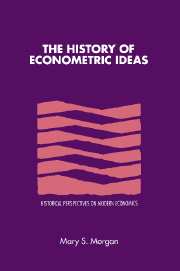Book contents
- Frontmatter
- Contents
- List of figures
- Preface
- Acknowledgements
- Introduction
- Part I Business cycles
- Part II Demand analysis
- Introduction to demand analysis
- 5 Narrowing the data-theory gap in demand analysis
- 6 The evolution of identification questions
- Part III Formal models in econometrics
- Conclusion
- References
- Index
6 - The evolution of identification questions
Published online by Cambridge University Press: 26 October 2009
- Frontmatter
- Contents
- List of figures
- Preface
- Acknowledgements
- Introduction
- Part I Business cycles
- Part II Demand analysis
- Introduction to demand analysis
- 5 Narrowing the data-theory gap in demand analysis
- 6 The evolution of identification questions
- Part III Formal models in econometrics
- Conclusion
- References
- Index
Summary
It is no accident that the standard economic model used in textbooks to illustrate the identification problem in econometrics is the simple market demand and supply model, for it was while attempting to estimate demand elasticities that pioneering econometricians first discovered the identification problem and related correspondence problems.
In a general sense identification is concerned with the correspondences between economic activity, the data that activity generates, the theoretical economic model and the estimated relationship. In early econometric work on demand, these correspondence problems were attacked in various ways. In some cases, investigators examined their data to see which relationships could be estimated and then sought to interpret these relationships in terms of economic theory. This involved two ideas of identification: one of identifying as ‘interpreting’ an estimated relationship in terms of economic theory, and secondly, one of identifying as ‘locating’ a relationship in the data. This notion of locating a relationship in the data has its closest modern counterpart in economic time-series analysis, which is concerned with finding a model which characterises the data given certain criteria. In other early work, investigators started with economic theory models and examined the circumstances under which these models could be estimated. This latter approach is nearest to the present-day scope of ‘the identification problem’, which deals with the question of whether the parameters of a model can be uniquely determined, given that the model is known (that is, assumed to be the ‘true’ model).
- Type
- Chapter
- Information
- The History of Econometric Ideas , pp. 162 - 190Publisher: Cambridge University PressPrint publication year: 1990

